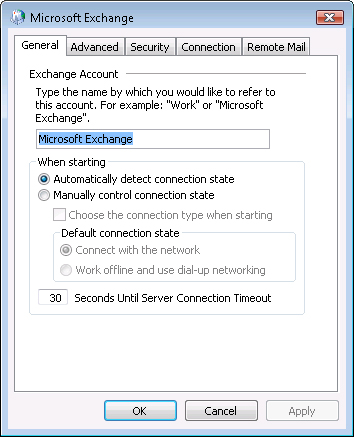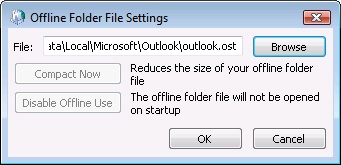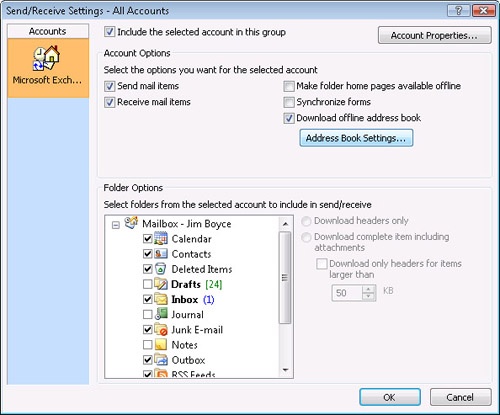There are a few specific issues and settings you need to consider when working with Outlook 2007 offline. This section explains how to configure the Outlook 2007 startup mode and offline folders and how to use an offline address book.
When you start Outlook 2007, it attempts by default to determine the online or offline status of the server. If the server is unavailable and Outlook 2007 is configured with an OST file, Outlook 2007 starts in offline mode and uses the offline folder specified in your profile for displaying existing items and storing new items (such as e-mail messages) before synchronizing with Exchange Server. With Cached Exchange Mode enabled, Outlook 2007 automatically uses the local cache (stored in an OST file) and attempts to synchronize the cached copy with your Exchange Server mailbox if a server connection is available. If you configured autodial in your operating system, Outlook 2007 dials the connection to the Internet service provider (ISP) or RAS server. However, you might want to exercise more control over the Outlook 2007 startup mode and when it connects. For example, you might prefer to have Outlook 2007 start in offline mode so that you can compose messages or perform other tasks before you connect and synchronize with the server.
You configure startup options by setting the properties for the Exchange Server account in your profile, as outlined in the following steps:
Right-click the Office Outlook icon on the Start menu and then click Properties or double-click the Mail icon in Control Panel (Classic View).
If you don’t use multiple profiles, skip to step 3. If you use multiple profiles, click Show Profiles. Select the profile you want to change and then click Properties.
Click E-Mail Accounts.
Select the Exchange Server account and then click Change.
If you decide to use Cached Exchange Mode, you can click the Use Cached Exchange Mode option; otherwise, click More Settings and then click the General tab (see Figure 43-1.)
Configure the following settings:
Automatically Detect Connection State. Outlook 2007 detects the connection state at startup and enters online or offline mode accordingly (selected by default).
Manually Control Connection State. You control the connection state when Outlook 2007 starts. The following three options work in combination with this option.
Choose The Connection Type When Starting. Outlook 2007 prompts you to select the connection state when it starts. This enables you to select between online and offline states.
Connect With The Network. Connect through your local LAN to Exchange Server. You can use this option if you connect to the Internet through a dedicated connection such as a cable modem or a Digital Subscriber Line (DSL) connection (selected by default).
Work Offline And Use Dial-Up Networking. Start in an offline state and use Dial-Up Networking to connect to Exchange Server. On the Connection tab, specify the dial-up connection you want to use.
Seconds Until Server Connection Timeout. Specify the timeout, in seconds, for the server (30 seconds by default). Outlook 2007 attempts a connection for the specified amount of time; if Outlook 2007 is unable to establish a connection in the specified period, it times out. You might want to increase this setting if you connect to the Internet through a shared dial-up connection hosted by another computer on your LAN.
Note
See the sidebar "Inside Out: Increase TCP Time-Out for On-Demand Connections" in Chapter 41 for details on configuring the TCP/IP timeout.
Although you don’t have to use offline folders when you work with Exchange Server over a remote connection, you do need a set of offline folders to work offline. If you haven’t set up offline folders and can’t connect to the remote server, Outlook 2007 won’t start. One of your first tasks after you create your dial-up connection and configure your Exchange Server account should be to configure a set of offline folders. Note, however, that you don’t have to perform this step if you configure Outlook 2007 to use Cached Exchange Mode for your Exchange Server account. When you enable Cached Exchange Mode, Outlook 2007 automatically creates an offline store for you.
Note
See Chapter 41 for more information on enabling Cached Exchange Mode.
You can associate one set of offline folders with the Exchange Server account in your profile. The offline file has an OST file extension and stores a copy of all the folders and items in your Exchange Server mailbox. Outlook 2007 synchronizes the data between the two. For example, suppose that you create an e-mail message and a new contact item while working offline. The message goes in the Outbox folder of the offline store, and the new contact item goes in the Contacts folder of the offline store. When you next connect to the server and perform synchronization, Outlook 2007 moves the message in the local Outbox to the Outbox folder on your Exchange Server, and the message then gets delivered. Outlook 2007 also copies the new contact item in your local Contacts folder to the Contacts folder stored on the Exchange Server. Any additional changes, including those at the server (such as new e-mail messages waiting to be delivered), are copied to your local offline folders.
Note
The OST file does not appear as a separate set of folders in Outlook 2007. In effect, Outlook 2007 uses it transparently when your computer is offline.
An OST file, like a personal folders (PST) file, contains Outlook 2007 folders and items. One difference, however, is that you can have only one OST file, but you can have multiple PST files. Also, Outlook 2007 synchronizes the offline store with your Exchange Server automatically but does not provide automatic synchronization for PST files.
Note
For more information on adding PST files to a profile, see "Adding Other Data Stores," in Chapter 3.
Follow these steps to configure offline storage with an OST file:
If Outlook 2007 is running, click Tools, Account Settings. Otherwise, right-click the Office Outlook icon on the Start menu, click Properties, and then click E-Mail Accounts.
Select the Exchange Server account and click Change.
To use offline folders without Cached Exchange Mode, clear the Use Cached Exchange Mode check box in the Change E-Mail Account dialog box.
Click More Settings and then click the Advanced tab.
Click Offline Folder File Settings to open the dialog box shown in Figure 43-2.
In the File box, specify a path and name for the OST file and click OK.
On the Advanced tab, click OK.
Click Next and then click Finish.
Note
This option to configure the offline folder store might be dimmed (disabled) if you have only an Exchange e-mail account configured, yet it can be enabled if you have multiple types of e-mail accounts. If you have a POP3 account configured, for example, and you add an Exchange account, the capability to configure the offline storage location is enabled.
After you add an OST file to your profile, you need to synchronize the file with your Exchange Server mailbox at least once before you can work offline.
Follow these steps to synchronize your offline folders:
Connect to the remote network where the computer running Exchange Server is located using the Internet, a dial-up connection to a remote access server on the remote LAN, or other means (such as ISDN, cable modem, or DSL). A LAN connection will give you the best performance for the initial synchronization.
Open Outlook 2007.
Click Tools, Send/Receive, This Folder (Microsoft Exchange); or select Tools, Send/Receive, Microsoft Exchange Only, Inbox. Outlook 2007 then synchronizes with the Exchange Server.
The preceding section explained how to synchronize your offline folders and your Exchange Server mailbox. Sometimes, though, you might not want to synchronize all folders each time you perform a send/receive operation. You can use send/receive groups to define the actions that Outlook 2007 takes when sending and receiving. For example, you might want to create a send/receive group that sends only mail waiting in your local Outbox and doesn’t retrieve waiting messages from the server.
Note
For a detailed discussion of send/receive groups, see "Controlling Synchronization and Send/Receive Times" in Chapter 8.
Whether you’re composing messages offline or creating tasks to assign to others, chances are good that you want access to your Exchange Server address book so that you can address messages to other users in your organization. If the Global Address List (GAL) doesn’t change very often on the server (if, for example, employee turnover at your company is low), you can get by with downloading the offline address book infrequently. Otherwise, you’ll need to update the offline address book more often.
Note
You can download additional address lists from the server if the Exchange Server administrator has created additional address books and given you the necessary permissions to access them. Additional address books give you quick access to addresses that are sorted using different criteria than the GAL uses or access to other addresses not shown in the GAL (such as external contacts).
To download the address book manually whenever you want an update, follow these steps:
Click Tools, Send/Receive, Download Address Book to open the Offline Address Book dialog box (see Figure 43-3).
Select options as needed from the following:
Download Changes Since Last Send/Receive. Download only changes made since the last time you performed a send/receive operation. Clear this check box to download the entire address list.
Full Details. Download all address information, including phone, fax, and office location. You must select this option if you want to send encrypted messages because you need the users’ digital signatures.
No Details. Download only e-mail addresses and no additional address book details.
Click OK to download the address book.
In addition to performing manual offline address book updates, you also can configure a send/receive group to download the address book.
Follow these steps to do so:
In Outlook 2007, click Tools, Send/Receive, Send/Receive Settings, Define Send/Receive Groups.
Select the send/receive group in which you want to configure the address book download and then click Edit.
On the Accounts bar, select your Exchange Server account (see Figure 43-4).
Select the Download Offline Address Book check box and then click Address Book Settings to open the Offline Address Book dialog box.
Configure settings as necessary in the Offline Address Book dialog box (discussed in the preceding set of steps) and then click OK.
Click OK to close the Send/Receive Settings dialog box.
Each time you synchronize folders using the send/receive group, Outlook 2007 downloads the offline address book according to the settings you specified. You probably don’t want to configure this option for the default All Accounts send/receive group unless you have a fast connection to the server and your offline address book changes frequently. One option is to create a send/receive group that downloads only the offline address book and does not process any other folders. However, this is essentially the same as choosing Tools, Send/Receive, Download Address Book. Consider how often you need to download the address book and work that task into your send/receive groups as you see fit.




